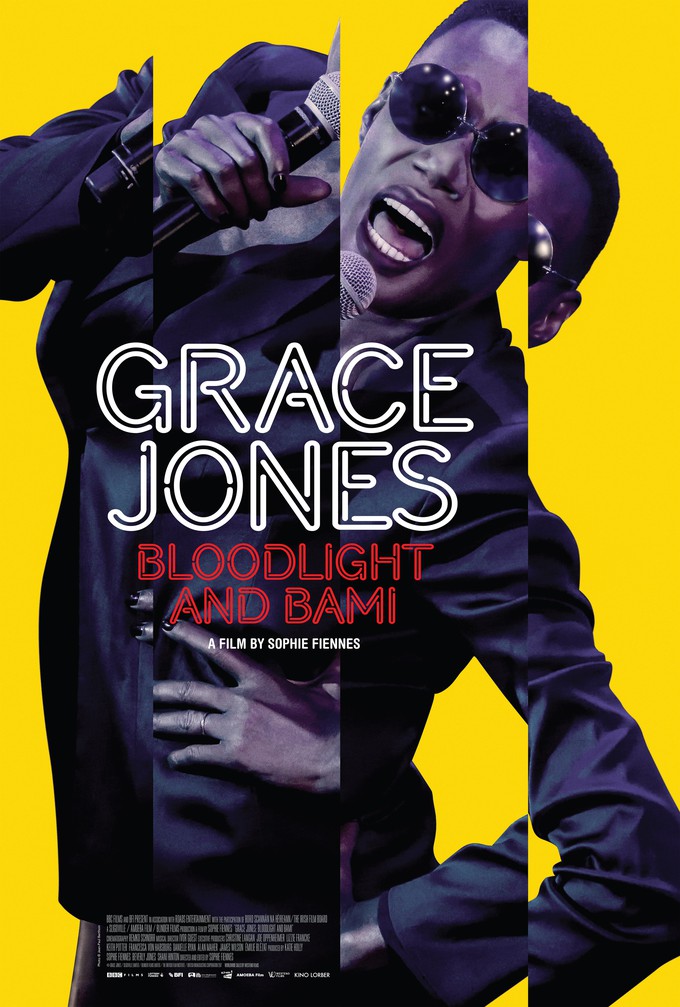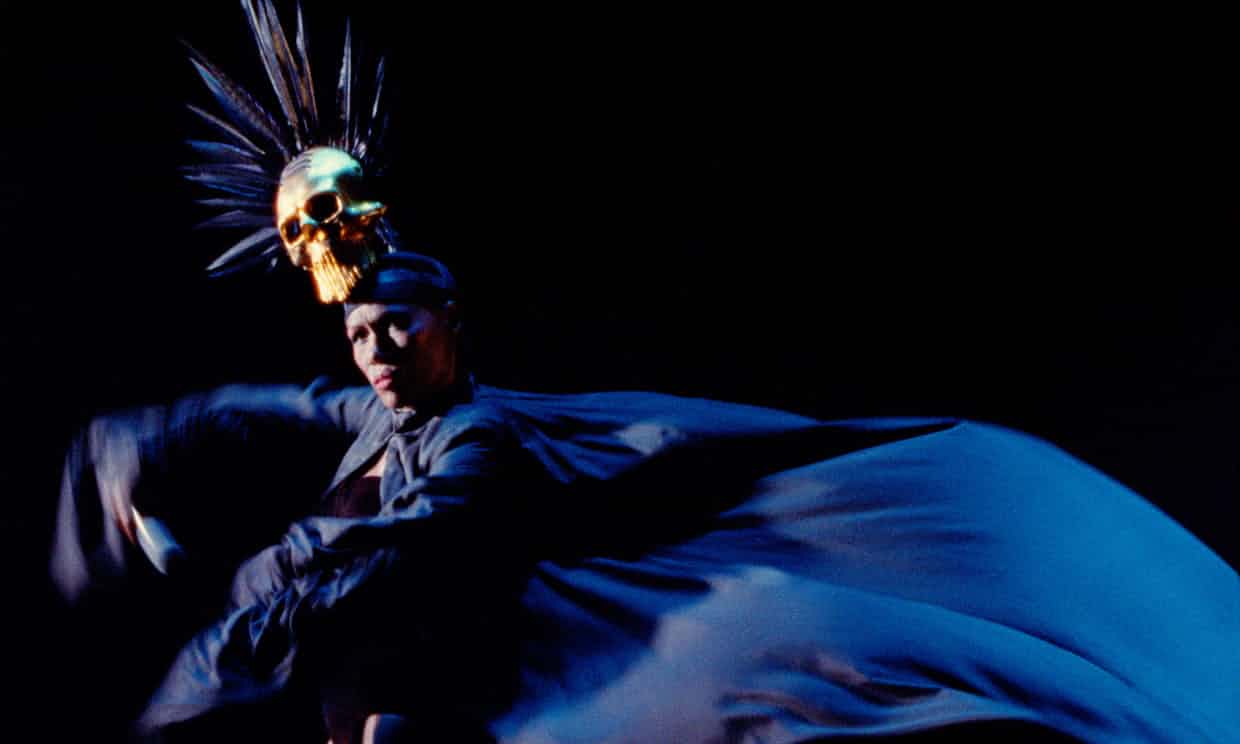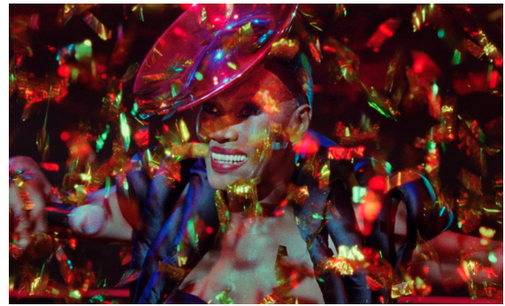Doc Corner: 'Grace Jones: Bloodlight and Bami'
 Tuesday, April 3, 2018 at 2:00PM
Tuesday, April 3, 2018 at 2:00PM By Glenn Dunks
 Documentaries about musicians can feel like a dime a dozen. It’s no wonder, too, since they’re such easy sells for festivals and home entertainment in a market that is over-saturated with exhibitors and distributors in need to properties that don’t require elaborate marketing campaigns -- just a hope and a prayer that they will ‘catch on’.
Documentaries about musicians can feel like a dime a dozen. It’s no wonder, too, since they’re such easy sells for festivals and home entertainment in a market that is over-saturated with exhibitors and distributors in need to properties that don’t require elaborate marketing campaigns -- just a hope and a prayer that they will ‘catch on’.
Grace Jones: Bloodlight and Bami is not exactly one of those films. It is unconventional as rock docs go in a whole host of ways, but it’s also a film that even its subject’s fans may struggle with. It eschews a typical birth-to-death narrative and instead focuses on Grace’s experiences in Jamaica and Paris recording her 2008 album Hurricane, recorded in garish lo-fi digital video, juxtaposed against richly filmed concert footage that echoes her 1982 One Man Show. It’s a documentary that leaves questions – like what exactly are “Bloodlight" and "Bami” (I had to look them up)? Why did it take so long to complete?

It drifts by for 115 minutes on its own sort of trippy wavelength which is, if you think about it, entirely appropriate for a documentary about Miss Grace Jones, one of the most enigmatic and exciting pop stars of the 20th century...
“Ladies and gentlemen… Miss Grace Jones” is probably the only way anybody could acceptably begin a film like Grace Jones: Bloodlight and Bami, the iconic words that begin her experimental Slave to the Rhythm album and let me tell you I was giddy. The LCD neon that floods the screen from the live performance footage promises a big screen experience that a performer of Jones’ skills and attention to design deserves. It’s a surprise then to see the cut to the off-stage material, which is shot so roughly with muddy colours and no clear obvious artistic reasoning. It turns out it actually works, offering a stylistic counterpoint that not only amplifies the concert footage, but also allows for this part of Grace to avoid the stylistic trappings that could otherwise distract us from getting a glimpse of, to quote unquote, the real Grace Jones.
In these sequences, predominantly filmed across Jamaica as well as Paris, Fiennes’ camera lingers on Jones significantly in close-up, allowing us to truly experience her anger as she deals with an uncooperative Sly & Robbie or in the film’s most surprisingly majestic and elegiac image a solitary Jones as she swims in a lake bathed only in moonlight, the camera zooming in from the shore to glimpse her face, her thoughts a mystery. There are other sequences where Fiennes simply leaves a camera in her subject’s hotel room and allows a drama to unfold with no directorial fuss.
However, Fiennes’ keenest directorial choices is a shot that doesn’t involve Jones at all! Jones has agreed to perform “La Vie en Rose” on French television to help pay for her album only to discover the dancers are dressed in pink negligees. As Jones performs, clearly perplexed by what’s happening around her on stage, Fiennes (who also edited) cuts to a crowd shot of two severely unimpressed teenagers. She lingers on them for longer than she probably ought to, but the result is probably the funniest single scene I’ll seen all year.
Fans expecting discussion of her albums, or film works like Boomerang, A View to a Kill, or Vamp will be sorely disappointed, although there is a drunken conversation on the floor of her dressing room about the infamous talk show incident wherein she slapped Russell Harty.

It’s perhaps curious that I’m talking less about the performance side of Bloodlight and Bami than I am the rest of it. But then again, what is there to add? Anybody who’s been lucky enough to see her live, as I have, will know the power she brings to the stage. Whether she's hoola-hooping to “Slave to the Rhythm”, clashing symbols over her head to “Warm Leatherette”, or writhing about in front of a wind machine in an Eiko Ishioka costume to “Hurricane," her stage performance is a wonder. Amid all of that what makes Fiennes’ film work is that juxtaposition to the off-stage Grace, her own raging hurricane of emotions that the camera captures in surprising and intimate ways.
Release: Bloodlight and Bami is out in NYC next Friday (April 13th) and in LA a week later before expansion. It is also available on home entertainment in the UK.
Oscar Chances: Nah, it's way too rough around the edges even though the documentary branch is warm to music documentaries.



Reader Comments (3)
Love me some (hell, all of) Grace Jones and can't wait to see this.
Positively desperate to see this
Fucking love Grace Jones. She is an original and fierce as fuck. I also love Kim Wayans' impression of Jones on In Living Color:
https://www.youtube.com/watch?v=eQopdEwzRj0